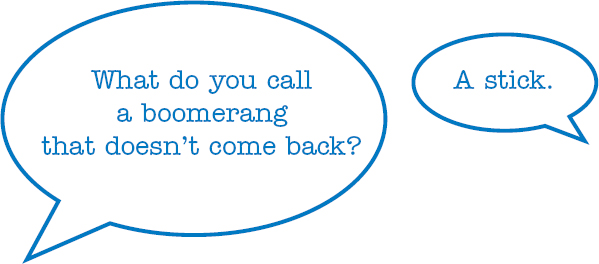
Unstressed syllables have reduced vowels and are said quickly.
There are two sounds that look similar but sound quite different. One is the tense vowel u, pronounced ooh, and the other is the soft vowel ü, whose pronunciation is a combination of ih and uh. The u sound is located far forward in the mouth and requires you to round your lips. The ü is one of the four reduced vowel sounds that are made in the throat: The most tense and highest in the throat is ε; next, slightly more relaxed, is i; then ü; and deepest and most relaxed is the neutral schwa ә. For the reduced semivowel schwa + R, the throat is relaxed, but the tongue is tense. (See also Chapters 1, 3, 5, and 12.)

Exercise 10-1: Comparing u and ü |
Look at the chart that follows and repeat each word. We are contrasting the sound u (first and third columns)—a strong, nonreducible sound, ooh, that is made far forward in the mouth, with the lips fully rounded—with the reduced ü sound in the second and fourth columns.
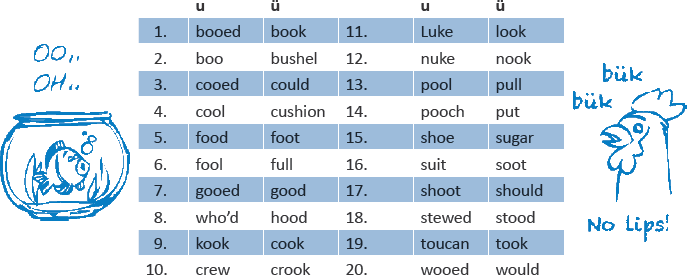
For the ooh sound, round your lips like a fish. For the ü sound, think of a chicken. Chickens don’t have lips, so they certainly can’t round them. You have to say ü down in the back of your throat.
Exercise 10-2: Lax Vowels |
The lax vowels are produced in the throat and are actually quite similar to each other. Let’s practice some lax vowels. (See also Chapter 12 to contrast with tense vowels.) Remember to double the vowel when the word ends in a voiced consonant.
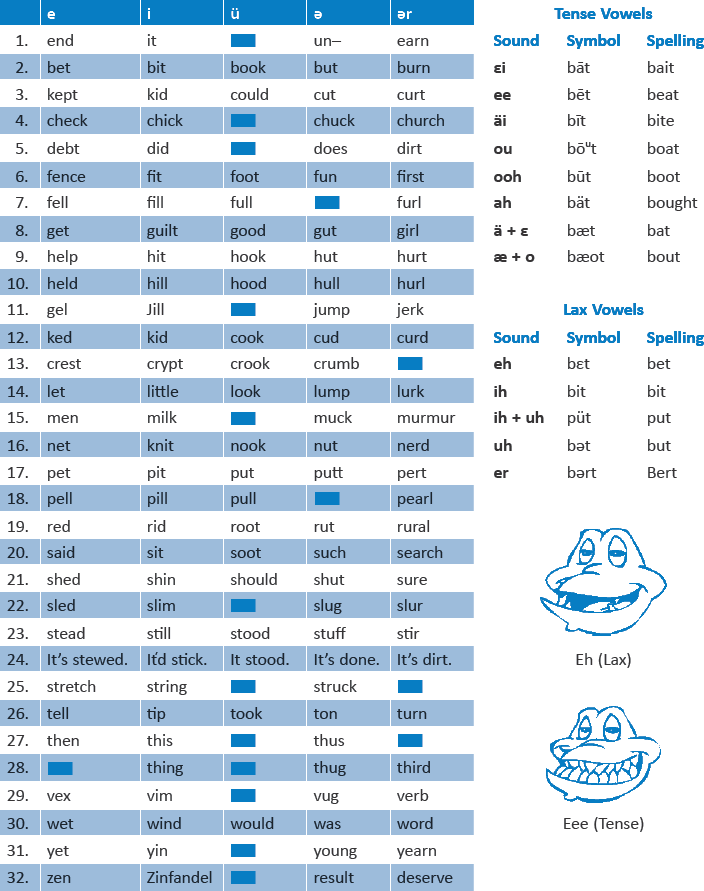
Exercise 10-3: Bit or Beat? |
We’ve discussed intonation in terms of new information, contrast, opinion, and negatives. As you heard earlier, Americans tend to stretch out certain one-syllable words . . . but which ones? The answer is simple—when a single-syllable word ends in an unvoiced consonant, the vowel is on a single stairstep—short and sharp. When the word ends in a voiced consonant, or a vowel, the vowel is on a double stairstep. (For an explanation of voiced and unvoiced consonants, click here.) You can also think of this in terms of musical notes.
Here you are going to compare the four words bit, bid, beat, and bead. Once you can distinguish these four, all of the rest are easy. Repeat.
|
single |
double |
tense |
beat |
bead |
lax |
bit |
bid |
Note You may hear tense vowels called long vowels, but this can cause confusion when you are talking about the long, or doubled, vowel before a voiced consonant. Use the rubber band to distinguish: Make a short, sharp snap for the single-note words (beat, bit) and a longer, stretched-out loop for the double-note words (bead, bid).
Exercise 10-4: Bit or Beat? Bid or Bead? |
Read each column down. Next, contrast the single and double tense vowels with each other, and the single and double lax vowels with each other.
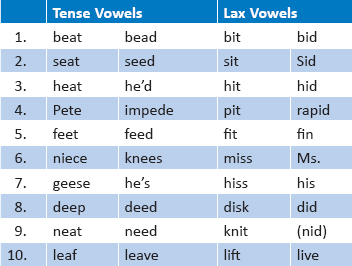
Finally, read all four across.
Note Bear in mind that the single/double intonation pattern is the same for all final voiced and unvoiced consonants, not just T and D.
Exercise 10-5: Tense and Lax Vowel Exercise |
Let’s practice tense and lax vowels in context. The intonation is marked for you. When in doubt, try to leave out the lax vowel rather than run the risk of overpronouncing it: l’p in place of lip, so it doesn’t sound like leap. Repeat:
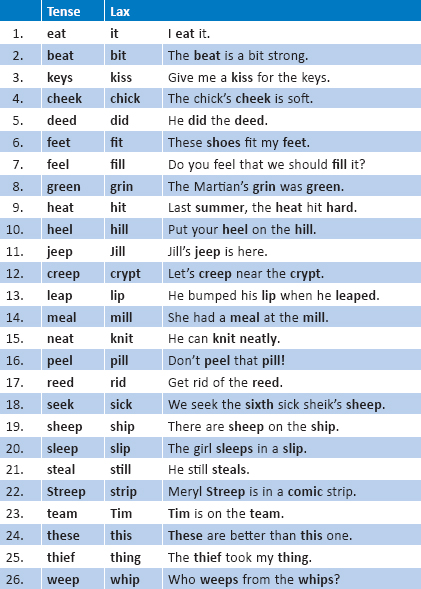
In the time you have taken to reach this point in the program, you will have made a lot of decisions about your own individual speech style. Pronunciation of reduced sounds is more subjective and depends on how quickly you speak, how you prefer to express yourself, the range of your intonation, how much you want to reduce certain vowels, and so on.
Exercise 10-6: The Middle “I” List |
The letter I in the unstressed position devolves consistently into a schwa. Repeat.
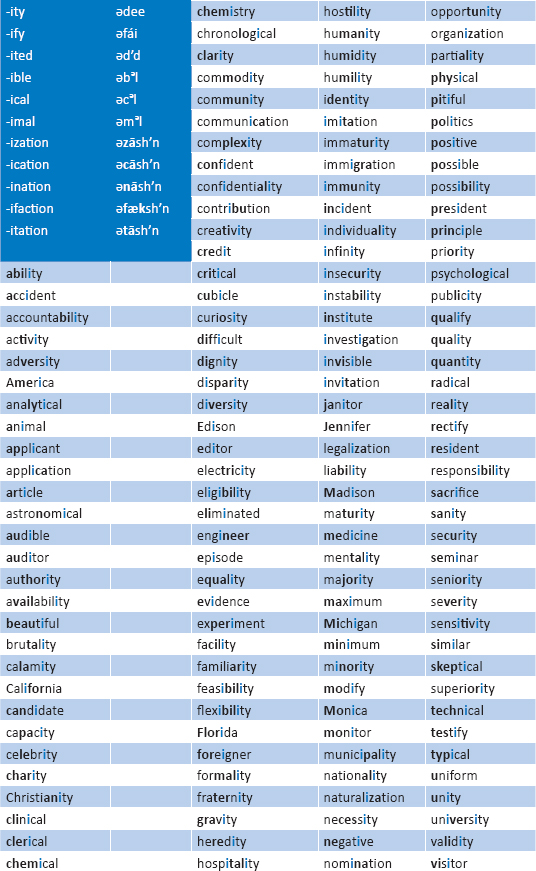
Exercise 10-7: Reduction Options |
In the following example, you will see how you can fully sound out a word (such as to), reduce it slightly, or do away with it altogether.
1.. . . easier tū(w)әnderstand.
2.. . . easier tü(w)әnderstand.
3.. . . easier tә әnderstand.
4.. . . easier tәnderstand.
5.. . . easier dәnderstand.
Each of the preceding examples is correct and appropriate when said well. If you have a good understanding of intonation, you might be best understood if you used the last example. How would this work with the rest of our familiar paragraph, you ask? Let’s see.
Go through the paragraph that follows and find the three ü’s and the five to seven u’s. Remember that your own speech style can increase the possibilities. With “to” before a vowel, you have a choice of a strong u, a soft ü, a schwa, or to telescope the two words and eliminate the vowel entirely. Mark the ü and u sounds. The first one is marked for you in blue. (Click here for answers.)
Hello, my name is______________. I’m taking American Accent Training. There’s a lot to learn, but I hope to make it as enjoyable as possible. I shüd pick up on the American intonation pattern pretty easily, although the only way to get it is to practice all of the time. I ūse the up and down, or peaks and valleys, intonation more than I used to. I’ve been paying attention to pitch, too. It’s like walking down a staircase. I’ve been talking to a lot of Americans lately, and they tell me that I’m easier to understand. Anyway, I could go on and on, but the important thing is to listen well and sound good. Well, what do you think? Do I?
ALL PREFIXES HAVE A SCHWA

Exercise 10-9: How Much Wood Would a Woodchuck Chuck? |
How fast can you say:
How much wood |
hæo mәch wüd |
would a wood chuck chuck, |
wüdә wüdchәk chәk |
if a woodchuck |
ifә wüdchәk |
could chuck |
cüd chәk |
wood? |
wüd |
|
|
How many cookies |
hæo meny cükeez |
could a good cook cook, |
cüdә güd cük cük |
if a good cook |
ifә güd cük |
could cook |
cüd cük |
cookies? |
cükeez |
In the following two exercises, we will practice the two vowel sounds separately.
Exercise 10-10: Büker Wülsey’s Cükbük |
Repeat after me.
Booker Woolsey was a good cook. One day, he took a good look at his full schedule and decided that he could write a good cookbook. He knew that he could, and thought that he should, but he wasn’t sure that he ever would. Once he had made up his mind, he stood up, pulled up a table, took a cushion, and put it on a bushel basket of sugar in the kitchen nook. He shook out his writing hand and put his mind to creating a good, good cookbook.

Exercise 10-11: A True Fool |
Repeat after me.
A true fool will choose to drool in a pool to stay cool. Who knew that such fools were in the schools, used tools, and flew balloons? Lou knew and now you do, too.

YOD DROPPING
People often ask if Tuesday and newspaper are pronounced Tiuzday and niuzpaper or Toozday and noozpaper. Most Americans tend toward the latter, but you can go either way. On some words, however, you cannot add that extra i sound, as with shoes or cool.
